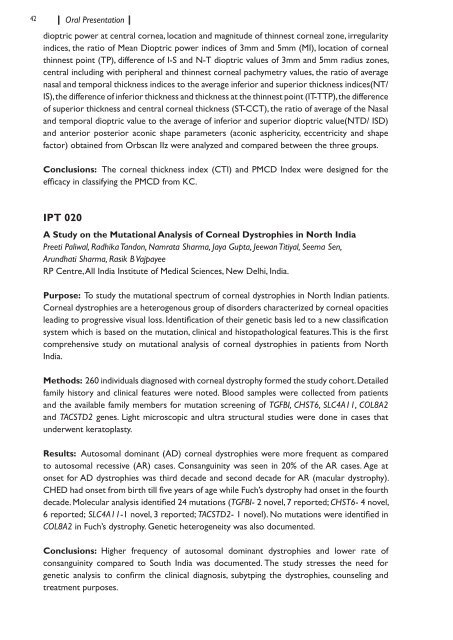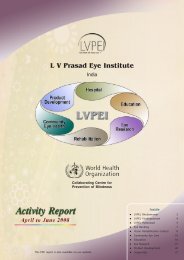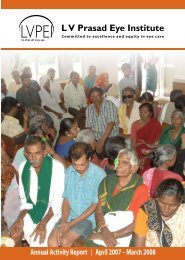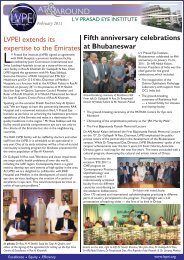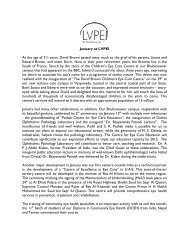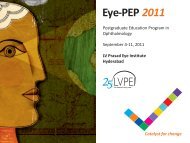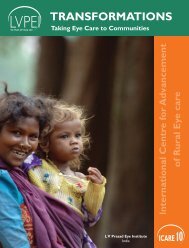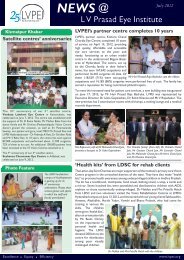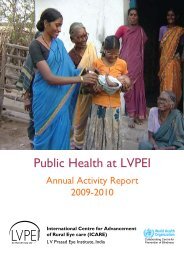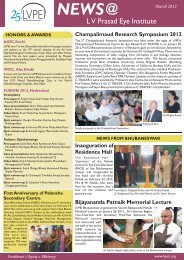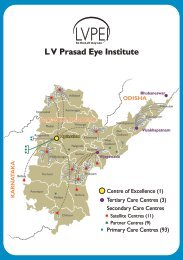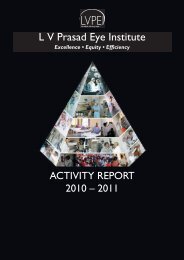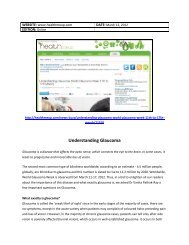IERG Abstracrt Book.indd - LV Prasad Eye Institute
IERG Abstracrt Book.indd - LV Prasad Eye Institute
IERG Abstracrt Book.indd - LV Prasad Eye Institute
Create successful ePaper yourself
Turn your PDF publications into a flip-book with our unique Google optimized e-Paper software.
42 Oral Presentationdioptric power at central cornea, location and magnitude of thinnest corneal zone, irregularityindices, the ratio of Mean Dioptric power indices of 3mm and 5mm (MI), location of cornealthinnest point (TP), difference of I-S and N-T dioptric values of 3mm and 5mm radius zones,central including with peripheral and thinnest corneal pachymetry values, the ratio of averagenasal and temporal thickness indices to the average inferior and superior thickness indices(NT/IS), the difference of inferior thickness and thickness at the thinnest point (IT-TTP), the differenceof superior thickness and central corneal thickness (ST-CCT), the ratio of average of the Nasaland temporal dioptric value to the average of inferior and superior dioptric value(NTD/ ISD)and anterior posterior aconic shape parameters (aconic asphericity, eccentricity and shapefactor) obtained from Orbscan IIz were analyzed and compared between the three groups.Conclusions: The corneal thickness index (CTI) and PMCD Index were designed for theefficacy in classifying the PMCD from KC.IPT 020A Study on the Mutational Analysis of Corneal Dystrophies in North IndiaPreeti Paliwal, Radhika Tandon, Namrata Sharma, Jaya Gupta, Jeewan Titiyal, Seema Sen,Arundhati Sharma, Rasik B VajpayeeRP Centre, All India <strong>Institute</strong> of Medical Sciences, New Delhi, India.Purpose: To study the mutational spectrum of corneal dystrophies in North Indian patients.Corneal dystrophies are a heterogenous group of disorders characterized by corneal opacitiesleading to progressive visual loss. Identification of their genetic basis led to a new classificationsystem which is based on the mutation, clinical and histopathological features. This is the firstcomprehensive study on mutational analysis of corneal dystrophies in patients from NorthIndia.Methods: 260 individuals diagnosed with corneal dystrophy formed the study cohort. Detailedfamily history and clinical features were noted. Blood samples were collected from patientsand the available family members for mutation screening of TGFBI, CHST6, SLC4A11, COL8A2and TACSTD2 genes. Light microscopic and ultra structural studies were done in cases thatunderwent keratoplasty.Results: Autosomal dominant (AD) corneal dystrophies were more frequent as comparedto autosomal recessive (AR) cases. Consanguinity was seen in 20% of the AR cases. Age atonset for AD dystrophies was third decade and second decade for AR (macular dystrophy).CHED had onset from birth till five years of age while Fuch’s dystrophy had onset in the fourthdecade. Molecular analysis identified 24 mutations (TGFBI- 2 novel, 7 reported; CHST6- 4 novel,6 reported; SLC4A11-1 novel, 3 reported; TACSTD2- 1 novel). No mutations were identified inCOL8A2 in Fuch’s dystrophy. Genetic heterogeneity was also documented.Conclusions: Higher frequency of autosomal dominant dystrophies and lower rate ofconsanguinity compared to South India was documented. The study stresses the need forgenetic analysis to confirm the clinical diagnosis, subytping the dystrophies, counseling andtreatment purposes.


